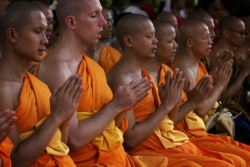Compassionate Means
The Buddha taught that to realize enlightenment, a person must develop two qualities: wisdom and compassion. Wisdom and compassion are sometimes compared The Tao of Harmony when the Yin and Yang aspects are equal. The word usually translated as “compassion” is karuna, which is understood to mean active Compassion. In practice, prajna gives rise to karuna, and karuna gives rise to prajna. Truly, you shouldn’t have one without the other. They are a essence to realizing enlightenment, and they are also enlightenment attained. It’s already been noted that compassion arises from wisdom, just as wisdom arises from compassion. . In Jodo Shin Shu, Compassion is toward the self, as if Charity begins at home. When a Myokonin was asked by a Zen Monk, can you say the Nembutsu for me? The Myokonin said, “No. Amidas benefit is just for me.” The Zen Monk said, “Can Amida Benefit me?” The Myokonin responded, “Yes, Amida can benefit only you.” If one where to eat spinach, the nutrition derived is only for you. We are also quite limited in our compassion. Bu tat does not mean not having compassion for others.
In the Lotus Sutra The Kannon Bodhisattva. Kannon personifies compassion and is one of the most widely worshipped Bodhisatva in Asia and Japan in both ancient and modern times. Kannon’s origins are unclear, but most scholars agree that Kannon worship began in India around the 1st or 2nd century AD and then spread to Southeast Asia, China, Korea, and most other Asian nations. Veneration of Kannon in Japan began in the late 6th century, There is also a Kwanon scet of Buddhism in Korea soon after Buddhism reached Japan by way of Korea and China. In Japan, Kannon’s paradise is known as Fudarakusen. It is commonly said to be located at the southern tip of India (which supports theories of Kannon’s Indian origin). Many Kannon statues from Japan’s Asuka Era (538 to 710) are still extant. Originally male in form, Kannon is now often portrayed as female in China, Japan, and other East Asian countries. Each of these nations dressed Kannon in different forms to suit their own temperaments and spiritual concepts. In the Kannon Sutra the Bodhisattva comes in various forms to save people in distress. Eshinni saw Shinran as an Incarnation of Kannon, which just means she saw him with the same compassionate regard and held him in high esteem. Kannon is an active emanation of Amida Buddha, and thus s/he occupies a major place in the liturgy of Japan’s Pure Land sects, whose principal deity of worship is Amida. In Mahayana Buddhism throughout Asia, Kannon is the most important of Amida’s two main attendants (kyōji). The other is Seishi Bosatsu. In Japan, the three appear in a popular grouping known as the Amida Sanzon (Triad, with Amida in the center, Seishi (representing wisdom) on the right, and Kannon (representing compassion) on the left. Nirvana Sutra along with his own commentaries and the writings of the Jodo Shinshu … Loving- kindness; Compassion; Sympathetic joy; Equanimity; Perfections; Enlightenment Qualities. Shinran said, not once have I said the Nembutsu for my parents. The benefit of Compassion is sometimes just for our selves. Nembutsu is the embodiment of purity, truth, goodness, beauty, wisdom and peace; in other words it embodies all the highest values and qualities both conceivable and inconceivable, which Amida was able to perfect in His infinitely long period of meditation and practice.

